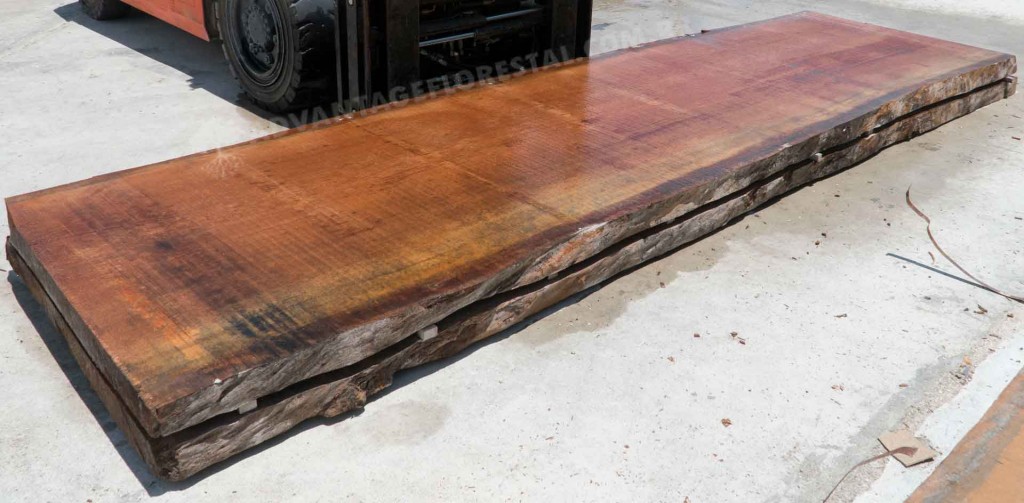
This tree grows very tall, up to 45 meters and has a wide clear bole. It ranges from a pinkish to reddish brown with a nice straight grain. The sapwood is anywhere from 3-6 cm thick and is demarcated from the heartwood as a pale yellow to off white color. The grain is straight and has the open pores that appear as a “hair-like” appearance. Much like that of genuine mahogany or teak. The autumnal and spring growth do not show large contrast and make for a very uniform slab. Being so wide and so tall Mandioqueira makes for a great slab. The sapwood looks as a frame around the heartwood which is very uniform and somewhat textured. There are occasional long black or dark streaks breaking up the uniformity and adding a sense of depth to the slab. It is about as hard as genuine mahogany and machines as well too. Machining will require sharp cutters due to silica content. Some of the best reasons to cut the highest quality logs into slabs are because: • Slabs have the highest yield of any form and using the most wood out of a tree is imperative to sustainable harvest which we are committed to • A slab that comes from a lesser quality log will be prone to be less stable • Voids in some logs means that they would not be suitable for slabs We believe that offering some of our Cambara in the highest possible yield is imperative to keep our wholesalers competitive in an ever changing wood world. Our experience with Cambara means you can always be assured that we will supply you the very best slabs. Just imagine being one of the few to be able to offer this species as a slab. This can be the thing that gives you an edge over your competitors and something very few mills can offer with integrity and quality. Give us a call or email us to see what we have available or what we are expecting to be available shortly.
Common Name: | Brazilian Mahogany, Cambara, Mandioqueira, Florecillo, Quaruba Rana |
Botanical Name: | Qualea spp |
Indigenous to: | Throughout tropical America from southern Mexico to Peru, but most abundantly in the Guianas and Brazil. |
Modulus of Rupture: | 20,000 lbf/in2 |
Shrinkage: | Tangential – 8.4% Radial – 4.4% Volumetric – 11.4% T/R Ratio – 1.9 |
How is it dried: | Kiln Dried (KD) |
Is it dried quickly: | Yes, but needs to be controlled as it will dry too fast unevenly if allowed to air dry in a non-controlled environment. |
Stability: | Cambara remains stable after the drying process but should not be left in the elements without some cover as it is rated as poor stability |
Exterior Wood Recommendation: | It can be used if only the heartwood is present. Sub species are commonly mixed together as there is no apparent differences to the naked eye. Some are more resistant to decay than others so it is best used as an interior wood. class 2 – inside or under cover (dampness possible) |
Fastening Method: | Should be predrilled for screws |
Ecosystem impact: | This tree is not threatened by any over-logging and is not listed on any CITES Appendices to be regulated for over logging. |
Toxicity and allergic reactions: | Rare to none |
Odor: | No distinct smell |
Products we manufacture using this species: | Info coming soon |
Other common uses: | Exterior joinery Exterior panelling Interior joinery Interior panelling Formwork Glued laminate Boxes and crates Veneer for interior of plywood Veneer for back or face of plywood Blockboard Light Carpentry Wood frame house Moulding Furniture or furniture components Sliced veneer Bridges (parts not in contact with water or ground) Wood-ware |
Susceptibility to | |
Dry Wood borers: | durable – sapwood demarcated (risk limited to sapwood) |
Fungi: | class 3 – moderately durable |
Termites: | class S – susceptible |
Treatability: | class 2 – moderately permeable |
Janka Hardness: | |
More Product Information
Cambara Wood Slabs – FSC® Certified is also available was last modified: May 8th, 2018 by

